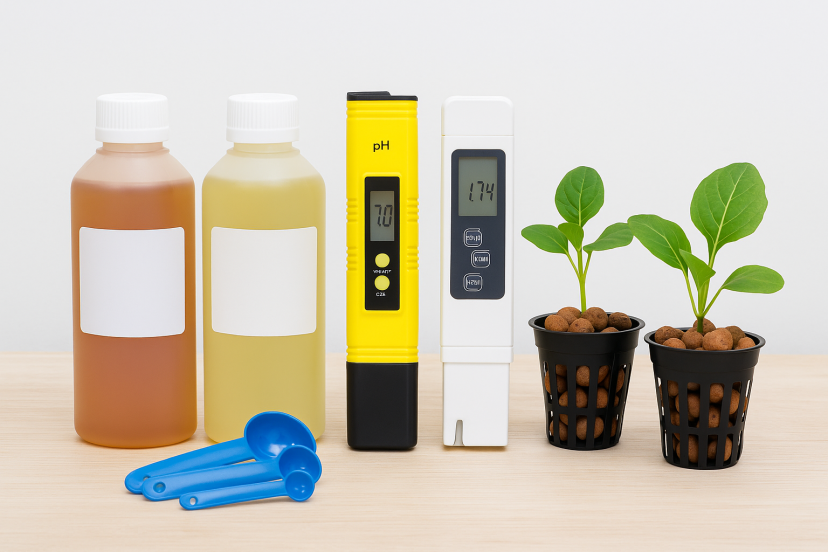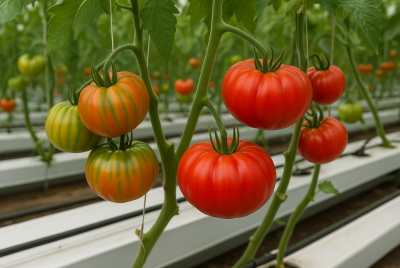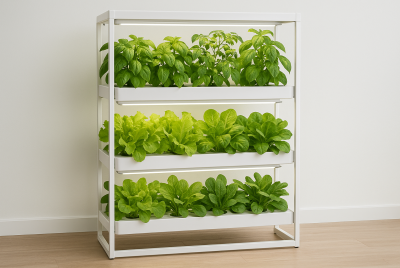Best Hydroponic Plant Food for Strong, Healthy Growth
We may earn a commission for purchases made using our links. Please see our disclosure for more details.
Your hydroponic setup feels perfect—bright lights, clear water, and healthy seedlings. But your plants still look slow or pale. The problem isn’t your system; it’s your hydroponic plant food. Plants cannot perform their best unless provided with the proper nutrients. They may live, but they will never genuinely prosper. The right nutrient mix can completely transform your garden, resulting in faster growth, thicker stems, and richer color. In this book, you will learn about the nutrients your system need to help your plants reach their maximum potential.
What Exactly Is Hydroponic Plant Food?
Hydroponic plant food is what keeps your plants alive without soil. In hydroponics, there’s no dirt to hold nutrients. Instead, you feed your plants with a nutrient-rich water solution that gives them everything they need to grow.
According to Atlas Scientific, a good hydroponic mix includes macronutrients, secondary nutrients, and micronutrients — all in balanced amounts that plants can absorb fast. The essential nutrients every hydroponic plant relies on are nitrogen (N), phosphorus (P), and potassium (K).
In order to stay strong and grow healthily, plants also require secondary minerals like calcium, magnesium, and sulfur. These assist with structure, photosynthesis, and enzyme function. Micronutrients, or small elements, are also important. In smaller doses, plants also require micronutrients such as iron, manganese, zinc, boron, and copper to support essential functions. Without them, your plants may turn yellow, stop growing, or become weakened.
All of these nutrients dissolve in water, forming a nutrient solution. Because there is no soil, the roots collect nutrients directly from the water. This accelerates and improves growth, but it also requires careful monitoring of pH and EC (electrical conductivity) levels. If they’re off, your plants won’t be able to absorb nutrients effectively.
In simple terms, hydroponic plant food replaces what soil normally provides. It gives you full control over how your plants eat, grow, and stay healthy in a clean, soil-free setup.
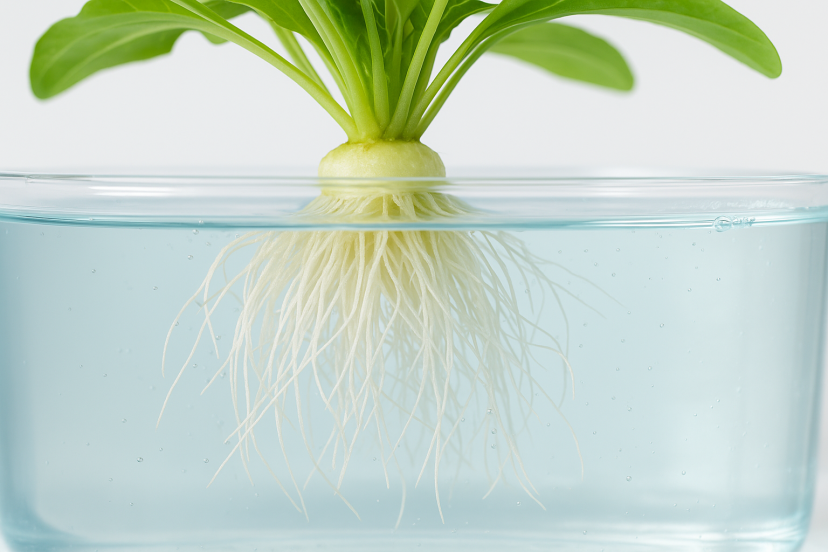
How Hydroponic Nutrients Work
Hydroponic feeding is all about precision and control. Because the nutrients are delivered directly to the roots, your plants can absorb them faster and more efficiently than in soil.
A 2020 study in Frontiers in Plant Science found that hydroponically grown lettuce absorbed 30% more nutrients and matured faster than soil-grown plants when supplied with a balanced nutrient mix. That’s the magic of direct feeding—every drop counts.
Here’s a quick look at how each element helps your plants thrive:
- Nitrogen (N): Builds chlorophyll and drives leafy growth.
- Phosphorus (P): Encourages root expansion and flower production.
- Potassium (K): Helps reinforce stems, regulate water movement, and improve a plant’s ability to resist disease.
- Calcium (Ca): Keeps cell walls strong, preventing deformities.
- Magnesium (Mg): Powers photosynthesis.
- Iron (Fe): Helps produce lush green leaves.
When your mix is balanced, plants flourish. But if one nutrient is off—even slightly—growth can stall or leaves can yellow quickly.
Choosing the Right Hydroponic Plant Food
Before buying any nutrient solution, think about your system type, plant variety, and growth stage. Here’s what to consider:
- N-P-K Ratio:
The numbers on the label (like 3-2-4) show the balance of nitrogen, phosphorus, and potassium. Leafy greens prefer more nitrogen; flowering plants want more phosphorus. - Organic vs. Synthetic:
- Organic nutrients come from natural materials such as seaweed, compost extracts, or fish-based emulsions. They’re eco-friendly but may cause more residue buildup.
- Synthetic nutrients are mineral salts that dissolve easily, offering precise control and fast results.
- Organic nutrients come from natural materials such as seaweed, compost extracts, or fish-based emulsions. They’re eco-friendly but may cause more residue buildup.
- Ease of Use:
Liquid solutions are simple for beginners—just mix with water. Powders or concentrates are better for advanced growers who want to fine-tune feeding. - pH Stability:
Nutrients only work if your water’s pH stays between 5.5 and 6.5. Choose a product that won’t cause major pH swings. - Crop Compatibility:
Not every nutrient line suits every crop. Always check whether it’s designed for herbs, leafy greens, or fruiting plants.
Top 5 Hydroponic Plant Food Products
Below are five trusted options that deliver strong growth, vibrant color, and healthy yields across different systems.
1. General Hydroponics Flora Series
A classic three-part formula (Grow, Micro, Bloom) used by beginners and professionals worldwide.
- Why it’s great: Customizable feeding ratios for every plant stage.
- Bonus: Backed by decades of lab testing and real-world success.
2. FoxFarm Grow Big Hydroponic Nutrient
Rich in earthworm castings, Norwegian kelp, and minerals, this formula promotes vigorous vegetative growth.
- Best for: Herbs, leafy greens, and hydro lettuce.
- Why it’s special: Contains natural boosters that enhance flavor and aroma.
3. Advanced Nutrients pH Perfect Grow, Micro, Bloom
A premium system that automatically balances your solution’s pH—ideal for busy growers.
- Key benefit: No pH pens required.
- Why it’s great: Highly efficient and forgiving for beginners.
4. Botanicare Pure Blend Pro Grow
A mostly organic blend with fish meal, kelp, and composted seabird guano.
- Eco angle: Perfect for sustainable hydroponics and eco-friendly gardeners.
- Bonus: Enhances the natural taste of herbs and fruits.
5. Technaflora Recipe for Success Starter Kit
Includes base nutrients, root stimulants, and boosters in one convenient box.
- Why it’s great: Easy-to-follow chart for every growth stage.
- Ideal for: New growers who want a guided start.
(Tip: Always follow the manufacturer’s feeding chart. Over-concentration can burn roots fast.)
Feeding Frequency and Best Practices
Hydroponic feeding depends on your system, plant type, and stage of growth—but consistency is key.
- Seedlings: Half-strength nutrient solution every 2–3 days.
- Vegetative Stage: Full-strength feeding daily or during each reservoir top-up.
- Flowering/Fruiting: Increase phosphorus and potassium levels for blooms and fruit development.
Always monitor electrical conductivity (EC) and pH using a digital meter. EC tells you how concentrated your solution is—too high causes “nutrient burn,” too low leads to deficiencies.
Pro tip: Empty and refill your reservoir weekly to prevent salt buildup and bacterial growth. Clean systems grow stronger roots and produce higher yields.
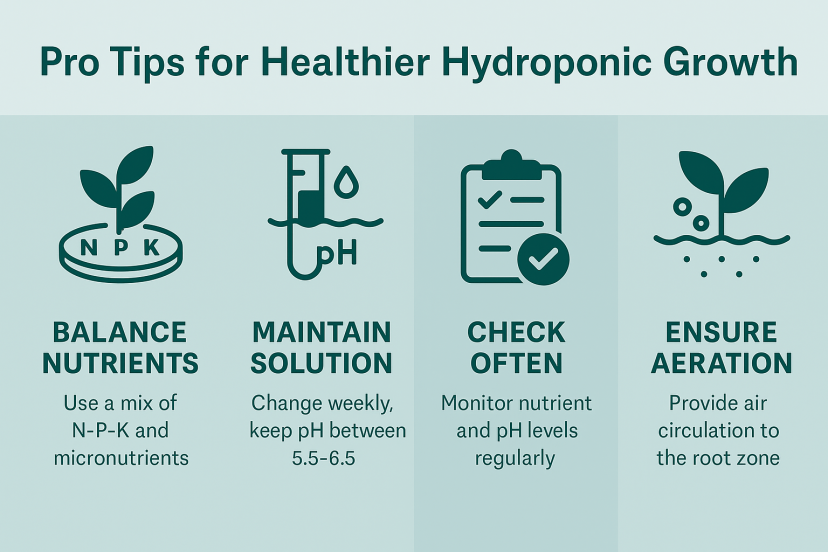
Pro Tips for Healthier Hydroponic Growth
- Monitor pH daily: Hydroponic systems can shift quickly; stable pH means stable nutrition.
- Use filtered or distilled water: Tap water can alter nutrient balance with chlorine or minerals.
- Keep roots oxygenated: Use an air pump or stone to prevent root rot.
- Store nutrients in a cool, dark place: Heat and sunlight can break down their potency.
- Watch your plants closely: They’ll show you what they need—yellow leaves mean low nitrogen, brown tips often mean overfeeding.
If your plants look stressed, flush the system with clean water for 24 hours before re-feeding.
Conclusion
Hydroponic gardening gives you full control over plant growth. The right hydroponic plant food keeps your system balanced and your plants healthy. Start with a trusted nutrient mix, keep the pH steady, and feed consistently for the best results. Want to grow fresh greens anytime? Check out how to grow herbs year-round with your hydroponic setup.
Frequently Asked Questions
1. Can I use regular fertilizer in hydroponics?
No. Soil fertilizers often contain additives that can clog pumps or throw off pH balance.
2. How often should I refresh my nutrient mix?
At least once per week, or sooner if the EC and pH levels drift significantly.
3. What’s the right pH level for a hydroponics system?
Between 5.5 and 6.5, depending on your plants.
4. Should you go with organic nutrients or stick to synthetic ones?
Organic options are eco-friendly and enhance flavor; synthetics provide precise control and faster absorption.
5. How do I prevent algae or root rot?
Keep the reservoir covered, ensure proper aeration, and avoid light leaks into the nutrient solution.

